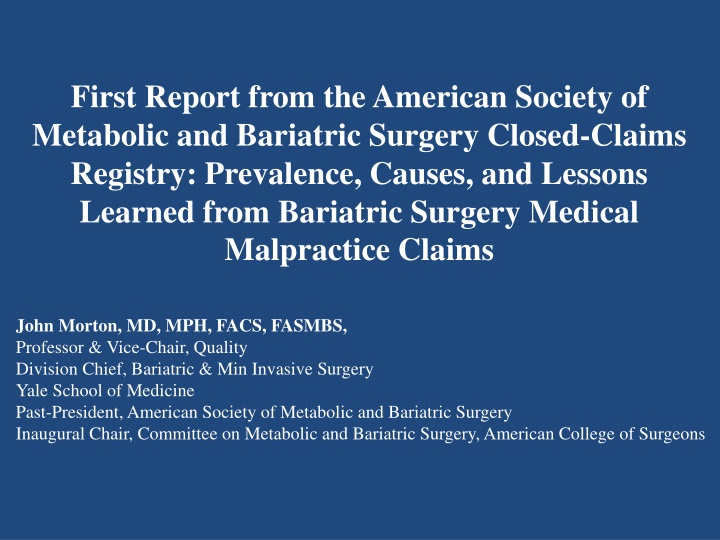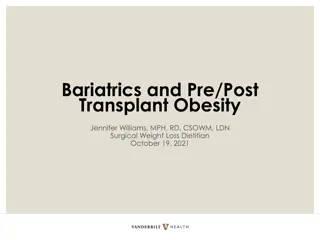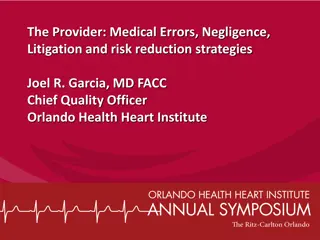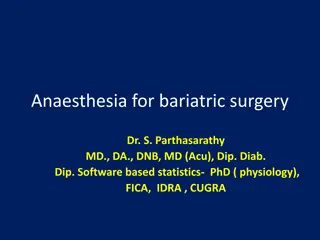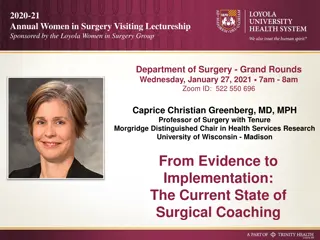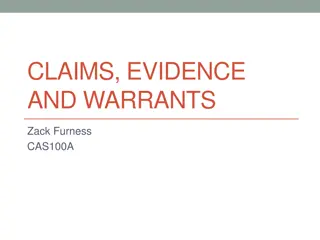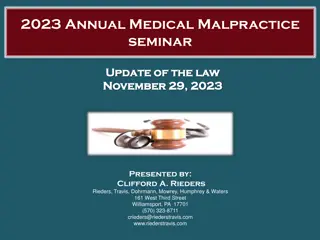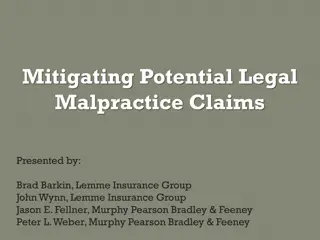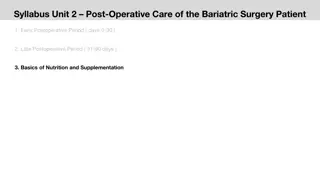Prevalence and Causes of Bariatric Surgery Medical Malpractice Claims
The American Society of Metabolic and Bariatric Surgery Closed-Claims Registry provides insights into malpractice claims in bariatric surgery, highlighting key data variables and methods used. The registry aims to improve patient care and safety by addressing lapses through thorough examination of specific episodes during bariatric procedures.
Download Presentation

Please find below an Image/Link to download the presentation.
The content on the website is provided AS IS for your information and personal use only. It may not be sold, licensed, or shared on other websites without obtaining consent from the author.If you encounter any issues during the download, it is possible that the publisher has removed the file from their server.
You are allowed to download the files provided on this website for personal or commercial use, subject to the condition that they are used lawfully. All files are the property of their respective owners.
The content on the website is provided AS IS for your information and personal use only. It may not be sold, licensed, or shared on other websites without obtaining consent from the author.
E N D
Presentation Transcript
First Report from the American Society of Metabolic and Bariatric Surgery Closed-Claims Registry: Prevalence, Causes, and Lessons Learned from Bariatric Surgery Medical Malpractice Claims John Morton, MD, MPH, FACS, FASMBS, Professor & Vice-Chair, Quality Division Chief, Bariatric & Min Invasive Surgery Yale School of Medicine Past-President, American Society of Metabolic and Bariatric Surgery Inaugural Chair, Committee on Metabolic and Bariatric Surgery, American College of Surgeons
Disclosures John M. Morton Ethicon , Olympus, Novo Nordisk- Consultant
Background The landmark Institute of Medicine Report To Err is Human highlighted the societal need to improve patient safety. Medical malpractice claims are often offered as a method of addressing lapses in patient care.
Background Bariatric surgery has experienced a tremendous improvement in patient outcomes. Despite excellent patient safety profile, malpractice coverage for bariatric surgery malpractice was initially difficult to obtain.
A bariatric surgery closed claims registry affords the opportunity to review specific episodes of care that may have opportunities for improvement. Background Here, we present the first bariatric surgery closed claims registry designed to examine prevalence and causes of malpractice claims.
Methods Four of the nation's major malpractice insurers agreed to participate in the American Society for Metabolic and Bariatric Surgery's Closed Claims Registry. The ASMBS Closed Claims Taskforce obtained primary data from direct abstraction on-site of insurance company's closed-claims files.
Methods Data abstraction included the following variables: Age Preoperative Body Mass Index Female Number of Comorbidities Surgeon Board Certified Surgeon Foreign Medical Graduate Hospital Accreditation Status Types of Procedures and Complications Monetary Awards and Lawsuit Expenses
Methods Following data abstraction, assessment of the clinical summary was provided on basis of the following categories: Diagnosis and treatment events Surgeon preoperative, intra-operative, post- operative, global assessment of care Care determination Communication concerns
Methods Complication preventable by surgeon, preoperative, intra-operative, post-operative care Role of language, informed consent, fatigue, distraction, workload clinical performance issues, equipment, or teaching hospital/trainee supervision Cause determination by provider, system and/or disease
Cause Determination NOT PREVENTABLE (CARE APPROPRIATE) HUMAN ERROR (PRACTITIONER IMPROVEMENT OPPORTUNITY-POSSIBLY PREVENTABLE) SIMPLE ERRORS OF DIAGNOSIS, TREATMENT, JUDGEMENT AT RISK BEHAVIOR (PREVENTABLE ERROR) CARE WHICH REQUIRES SIGNIFICANT EDUCATION OR COACHING TO PREVENT REOCCURENCE INAPPROPRIATE SEVERE (PREVENTABLE) CARE SUGGESTS RECKLESS DISREGARD OF SURGEON S DUTY TO PATIENT THROUGH GROSS NEGLIENCE, INCOMPETENCE OR ACTUAL INTENT TO PROVIDE SUBSTANDARD CARE
Results Preoperative Study Population Demographics Number of Patients, # 175 Age, n (mean SE) 44.4 1.0 BMI, (mean SE) 48.0 0.9 BMI >50, % 41.8 Female, % 70.2 Comorbidities, n (mean SE) 2.86 0.2 Type of Procedure, % LRYGB 45.6 Lap Band 18.1 Open Surgery 13.4 Sleeve Gastrectomy 8.1 Revision Surgery 4.0 Non-Standard Procedures 3.4 Band Removal 2.7 BPD/DS 2.7 Band to BPD/DS 2.0
Results Surgeon and Hospital Demographics Surgeon Board Certified, % 75.9 Surgeon Foreign Medical Graduate, % 27.5 Hospital Accredited, % 43.3
Results Clinical Complications Mortality, % 27.1 Leak, % 16.7 Bowel Obstruction, % 8.3 Surgical Technical Error, % 6.9 Wound Infection/Dehiscence, % 6.9 Bleeding, % 6.3 Perforation, % 6.3 Nutrient Deficiencies, % 4.9 Retained Foreign Body, % 4.2 Intra-Abdominal Abscess, % 3.5 Vascular Injury, % 3.4 Prolonged Nausea/Abdominal Pain, % 2.8 Ulcers/Stricture, % 2.1 Myocardial Infarction, % 0.7
Results Monetary Awards and Lawsuit Expenses* Monetary Awards, $ (Mean SE) 293,499.83 100,434.60 Expenses for Lawsuits, $ (Mean SE) 91,835.54 12,111.40 *The winner of the lawsuit was not recorded in the responses
Results Diagnosis Events 45 40 35 30 25 20 15 10 5 0 Misinterpreted Tests Misdiagnosis Other Diagnostic Issue Any "Diagnostic Event" Occurred No Diagnostic Event
Results Treatment Events 30 25 20 15 10 5 0
Results Complication Preventable by Surgeon 70 60 50 40 30 20 10 0 Yes No Impossible to Judge
Results Better Pre-Operative Care Prevent Complication 70 60 50 40 30 20 10 0 Yes No Impossible to judge
Results Better Post-Operative Care Prevented Complication 50 45 40 35 30 25 20 15 10 5 0 Yes No Impossible to judge
Results Factors Contributing to Complication 40 35 30 25 20 15 10 5 0
Results Clinical Performance Issues 40 35 30 25 20 15 10 5 0
Results Communication Issues 45 40 35 30 25 20 15 10 5 0 Insufficient Communication With Team Insufficient Communication With Patient/Family Disclosure Process Inadequate Incomplete Documentation Appropriate Communication Performance
Results Cause Determination 60 50 40 30 20 10 0 Provider-Related System-Related Disease-Related
Results Care Determination 25 20 15 10 5 0 Not Preventable Human Error At Risk Behavior Inappropriate Severe Care
Summary and Conclusion Prevalence of malpractice claims regarding bariatric surgery is low. Compared to national norms, malpractice claim patients were heavier and more often male.
Summary and Conclusion Surgeons who were involved with malpractice claims were less often board-certified Hospitals involved with malpractice suits had a much lower accreditation rate in comparison to national norms.
Summary and Conclusion Malabsorptive and non-standard procedures were over-represented in malpractice claims in comparison to MBSAQIP procedure rates. While mortality was the most common cause for malpractice suits, Bleeding, Retained foreign body, and Vascular injury occurred at higher rates than national averages.
Summary and Conclusion Failure to diagnose, Delay in Treatment, Postoperative Care and Communication domain responses indicate future opportunities for improvement
Future Steps Technical Leaks Vascular Access NGT Hernia Mngt Communication Standardized Hand-Offs Home Monitoring Non-Standard Procedures Update Closed Claims Registry
